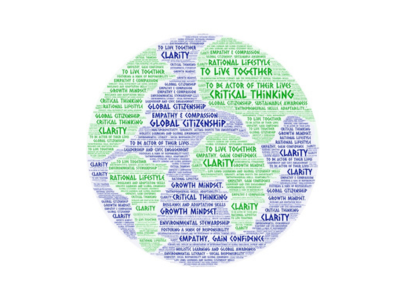By Andreea Gatman, Act On Learning
Oddience2030 teachers prioritizing “creativity and critical thinking”
Key ideas based on the assessment of the program
Based on the 67 registered teachers for the training program, when invited to reflect on what is the future they imagine for students learning with Sustainable Development Goals, most of the teachers prioritized critical thinking and creativity.
This data is reported before there was the strategic partnership decision based on project audit to choose 2 transversal competencies for a more directed outcome.
Here is a word map created by teachers answers before the program started (from January 2024)

The assessment confirms the intention
After each of the 4 modules, the assessment confirms the intention of prioritizing creativity and critical thinking.
Based on the toolkit to support each of the 4 modules, when asked “What is one thing that surprised your attention during the module” the majority chose creative tools for the classroom. Here are some of the teachers’ answers.
“I had the the ability to imagine just with the use of words, texture, learning with 5 senses as inward-outward attention”.
“ An individual’s perspectives towards a thing around them, following small steps that lead to a very thoughtful product, mental imagery and the power of imagination”
Critique... critical moving through a state of confusion
Some participants, reported in blog articles or through assessments, the state of confusion, more or less tolerated at some critical points.
Self reflecting, later on, they identified external factors-distractions, as being causes that made their learning harder or stopped it.
First emotions behind the creative process is the confusion, and tolerating, by which we mean having practices to stay and investigate gather new data (Hayashi, 2021, Kumar, 2021). Engaging pedagogies defined as this state of caring about what we learn and teach in the classroom, hence we teach students to tolerate confusion to unlearn in order to be ready to learn again, one cannot know how to hold confusion, without experiencing on themselves (Lonka, 2018).
In the process of “getting back” to clarity and coherence “that feel safe zone”.
We learn to offer grace to ourselves, and “trust the process” as preconditions of this work with emerging strategies. Grace is defined by vulnerability in the words of researcher Brene Brown “staying with all that comes at the limits of our comfort zone”, and where the learning zone starts (Vygotsky).
Facilitation, as the etymologically means “a certain ability to feel at ease with what otherwise is hard or difficult work” and this speaks about the inner process, of the teacher as part of “teaching with Sustainable Development Goals.”
Work in progress To be continued…
“In the end what we want from this creative pedagogical prototype of a lesson, is for the students and teachers to have an image of us valuing connection, beyond all tasks, beyond the result, to have this agreement.”
(Marie Alice Moreira, teacher from Bel Orme)

